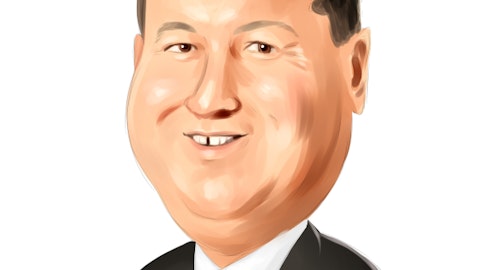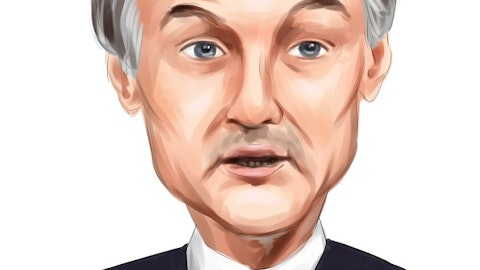In this article, we discuss the top 10 stock picks of Sculptor Capital. If you want to skip our detailed analysis of these stocks, go directly to Sculptor Capital’s Top 5 Stock Picks.
Sculptor Capital is a publicly listed global alternative asset manager, operating worldwide from offices in New York City, London, Hong Kong, Mumbai, and Shanghai. Sculptor Capital was previously known as OZ Capital Management Group, founded by Daniel Och in 1994. In 2018, Och stepped down from his role at the hedge fund, and currently Jimmy Levin is the chief investment officer and CEO of Sculptor Capital.
As of November 1 2021, the hedge fund has discretionary assets under management amounting to $37.2 billion. The investments at Sculptor Capital are focused in the information technology, finance, healthcare, consumer discretionary, and communications sectors, with Amazon.com, Inc. (NASDAQ:AMZN) being the largest holding as of Q3. Investments are carefully scrutinised via the fund’s multi-strategy approach, resulting in diverse asset classes and a unique portfolio, that serves clients including corporate pension funds, fund of funds, endowments and foundations, as well as sovereign wealth and corporates.

The most notable stock picks of Sculptor Capital as of the latest Q3 filings include Mastercard Incorporated (NYSE:MA), Netflix, Inc. (NASDAQ:NFLX), Amazon.com, Inc. (NASDAQ:AMZN), and Microsoft Corporation (NASDAQ:MSFT), among others discussed in detail below.
Our Methodology
With this context in mind, let’s discuss the top 10 stock picks of Sculptor Capital. We mention the Q3 earnings, analyst ratings, and the hedge fund sentiment around each stock to give readers a better understanding of each company.
10. Hilton Worldwide Holdings Inc. (NYSE:HLT)
Sculptor Capital’s Stake Value: $236,391,000
Percentage of 13F Portfolio: 1.94%
Number of Hedge Fund Holders: 44
Hilton Worldwide Holdings Inc. (NYSE:HLT), a multinational American hospitality corporation, is recognized for its rich portfolio of assets including hotel establishments and resorts. Among its 18 signature hotel brands, the most well known are Hilton Grand Vacations, Waldorf Astoria Hotels & Resorts, Hilton Hotels & Resorts, and Hampton by Hilton, among others.
Sculptor Capital holds a $236.3 million stake in Hilton Worldwide Holdings Inc. (NYSE:HLT), which represents 1.94% of the fund’s Q3 portfolio. The leading stakeholder in the company is Bill Ackman’s Pershing Square, with 12.88 million shares valued at $1.7 billion. Overall, 44 hedge funds tracked by Insider Monkey were bullish on Hilton Worldwide Holdings Inc. (NYSE:HLT) as of September, with a total stake value of $5.36 billion.
Hilton Worldwide Holdings Inc. (NYSE:HLT), on October 27, posted its Q3 earnings. EPS in the period totaled $0.78, missing estimates by -$0.06. The $1.75 billion revenue was up 87.46% from the prior-year quarter, beating estimated revenue by $56.41 million.
On October 28, BMO Capital analyst Ari Klein raised the price target on Hilton Worldwide Holdings Inc. (NYSE:HLT) to $144 from $135 but kept a Market Perform rating on the stock following the Q3 results. The analyst was also positive that demand for the hospitality industry would grow, and occupancy rates would be better as a result.
In addition to Mastercard Incorporated (NYSE:MA), Netflix, Inc. (NASDAQ:NFLX), Amazon.com, Inc. (NASDAQ:AMZN), and Microsoft Corporation (NASDAQ:MSFT), Hilton Worldwide Holdings Inc. (NYSE:HLT) is a notable stock in Sculptor Capital’s Q3 portfolio.
Here is what Pershing Square Holdings has to say about Hilton Worldwide Holdings Inc. (NYSE:HLT) in its Q2 2021 investor letter:
“While the hotel industry has been extremely negatively impacted by the COVID-19 pandemic, Hilton has done an excellent job navigating industry volatility, a testament to the company’s high-quality, asset light, high-margin business model and superb management team. From the moment the pandemic began, Hilton’s management team took decisive actions to ensure the company not only managed through what it knew would be a challenging period, but also positioned the company to generate improved margins, cash flows and investment returns once the business recovers to pre-COVID-19 demand levels.
Industry RevPAR (the industry metric for same-store sales at a given hotel) bottomed in April 2020 and has shown sequential improvement every quarter as travel and mobility have recovered along with COVID-19 vaccine rollouts and a resumption in travel. In recent months, there is increasing evidence that a robust recovery scenario is underway, led by domestic leisure travel occasions which are currently trending above 2019 demand levels. For the first three weeks of July, the most recent data the company provided, RevPAR has already recovered to 85% of 2019 levels – a significant improvement over prior months driven by increased hotel occupancy and a rapid recovery in rate.
While management anticipates a moderation in leisure demand as we exit the summer, it expects the moderation in leisure travel to be offset by a more pronounced recovery in business transient travel occasions as offices reopen this fall. Although there remains near-term uncertainty in domestic travel given the increase in COVID-19 case numbers following the arrival of the Delta variant in the U.S., we believe that the medium-term outlook continues to point to a robust recovery scenario. Throughout the pandemic, Hilton took actions to reduce corporate expenses by about 20% compared to 2019 levels.
Simultaneously, the company provided resources and support to the Hilton owner community which further solidified Hilton as the preferred franchise partner, thereby expanding Hilton’s pipeline of units around the world.
In the most recent quarter Hilton affirmed its near-to-medium term outlook of mid-single-digit net unit growth, and a resumption of its historical 6-7% net unit growth beginning in 2023-2024, higher growth than competitors, and further evidence of Hilton’s unique business model.
We believe that Hilton will continue to grow its market share over time given independent hotels’ increased interest in seeking an affiliation with global brands, particularly in the wake of the pandemic. While the recovery may continue to be uneven, Hilton has made tremendous progress which will help it become an even more profitable and stronger business going forward.”
9. Anaplan, Inc. (NYSE:PLAN)
Sculptor Capital’s Stake Value: $245,581,000
Percentage of Sculptor Capital’s 13F Portfolio: 2.02%
Number of Hedge Fund Holders: 61
Anaplan, Inc. (NYSE:PLAN), an on-demand business planning software company, is one of the top stock picks of Sculptor Capital as of September 2021. The hedge fund owns over 4 million shares in the company, worth $245.5 million. Anaplan, Inc. (NYSE:PLAN) represents 2.02% of Sculptor Capital’s Q3 investments.
Anaplan, Inc. (NYSE:PLAN) posted its Q3 results on November 23, with EPS for the quarter being -$0.05, beating estimates by $0.06. The company’s revenue amounted to $155.35 million, up 35.23% year-over-year.
As of Q3 2021, 61 hedge funds in Insider Monkey’s database of 867 elite funds were bullish on Anaplan, Inc. (NYSE:PLAN), and reported owning stakes in the company worth $2.8 billion. This is an increase as compared to the prior quarter, with 52 funds holding a position in Anaplan, Inc. (NYSE:PLAN), with a total stake value of $2.1 billion. The leading stakeholder of Anaplan, Inc. (NYSE:PLAN) is Eric Bannasch’s Cadian Capital, with 5.3 million shares worth $323.7 million.
Here is what Alger Mid Cap Focus Fund has to say about Anaplan, Inc. (NYSE:PLAN) in their Q1 2021 investor letter:
“Anaplan, Inc. was among the top detractors from performance. Anaplan is a leading provider of cloud-based business planning software. Anaplan’s software platform aims to solve the most complex planning needs of large global enterprises across various business lines. Unlike traditional business planning software, which is often rigid, siloed and opaque, Anaplan’s platform is designed to enable broader enterprise participation and better workforce collaboration during the business planning process. Through better planning, large enterprises can more effectively allocate resources to cut costs and generate revenue. Today Anaplan has over 1,600 customers across a variety of end markets and business use cases.
Anaplan shares underperformed in the first quarter as part of a broader sector rotation as high-growth software stocks fell out of favor relative to more cyclically exposed investment opportunities. We believe Anaplan’s focus on growth over near-term profit generation negatively impacts the company’s stock in a rising interest rate environment.
Fundamentally, Anaplan had strong fourth quarter earnings result, with the company seeing an acceleration of billings growth and a strong demand pipeline as companies realize the need for a more flexible digital planning solution.”
8. The New York Times Company (NYSE:NYT)
Sculptor Capital’s Stake Value: $273,267,000
Percentage of Sculptor Capital’s 13F Portfolio: 2.25%
Number of Hedge Fund Holders: 45
The New York Times Company (NYSE:NYT) is an American media corporation known for publishing the New York Times newspaper. On November 2, Morgan Stanley analyst Thomas Yeh raised the price target on The New York Times Company (NYSE:NYT) to $65 from $60 and kept an Overweight rating on the stock. Sculptor Capital, as of Q3 2021, holds over 5.5 million shares in the company, worth $273.2 million, representing 2.25% of the fund’s total investments.
At the end of September, 45 hedge funds were long The New York Times Company (NYSE:NYT), with a total stake value of $2.43 billion, as reported by the database of Insider Monkey. The leading The New York Times Company (NYSE:NYT) stakeholder is Anand Desai’s Darsana Capital Partners, with a $418.7 million position in the company.
The New York Times Company (NYSE:NYT) posted its Q3 results on November 3. EPS in the period equaled $0.23, beating estimates by $0.02. The $509.1 million revenue was up 19.26% from the previous-year quarter, exceeding estimated revenue by $9.79 million.
Here is what Greenhaven Road Capital has to say about The New York Times Company (NYSE:NYT) in their Q4 2020 investor letter:
“The second significant investment that we made during the quarter was in The New York Times (NYT). The newspaper business is very challenged; in fact, industry wide revenues are hovering somewhere around the 1980s’ level and circulation sits at multi-decade lows. The NYT’s revenue rose by 14% from 2015 to 2019 (last full years available). No, that is not 14% per year, but rather 14% total over those five years. For many years, digital advertising was to be the savior of media companies, but this has not proven to be the hoped-for panacea as Google and Facebook have taken content from publishers under very depressed economics and digital ad rates have declined. The New York Times’ print subscriptions are down more than 50% from their peak and will likely trend to zero in the next decade.
While the top line quantitative data is underwhelming, the business is transitioning away from an advertising-supported to a subscription-supported model. In 2000, The New York Times’ revenue was made up of approximately 25% subscription and 75% advertising/other. Today those numbers are flipped, with approximately 75% of revenue earned from subscriptions.
The transition to a subscription-based business has been a gradual one for which The New York Times was ill-prepared. In 2011, the Times instituted a paywall to limit individuals’ monthly readership in order to drive heavy online consumers to begin to pay for continued access. In the decade since, they have gone through an iterative process of enhancing the marketing team, improving the technology, and experimenting with pricing tiers, products, and offerings. A subscription focused business requires different skills than an ad-supported organization. The latter is focused primarily on traffic, while the former is much more focused on customer acquisition costs, retention rates, and lifetime value of subscribers.
Subscribers are grouped into cohorts and segmented by areas of interest, frequency of consumption, type of content consumed, and breadth of content consumed. Over time, the tracking and marketing has gotten more sophisticated – figuring out better ways to nudge registered users to become subscribers and getting existing subscribers to renew. A registered user who only reads political articles may be sent targeted emails highlighting other types of content since people who come to the site for two or more content areas subscribe at much higher rates. Other tactics include varying introductory pricing by user type and adjusting renewal rates based on each individual user’s data profile. These changes have required the Times to improve technology and personnel at all levels of the company, including the board of directors, which is surprisingly tech savvy.
The New York Times actually gets better as it gets larger. There is a flywheel in effect: quality content drives subscriptions, which provide more resources for better content, which drives additional subscribers, which provides again more resources for content. The New York Times pays starting reporters two to three times the industry average, and, given they have four times the number of subscribers as their next-largest peer, they can hire the best talent. Recently, they have hired notable journalists Ezra Klein, Ben Smith, and Kara Swisher from small upstart competitors. The strong have gotten stronger. With their scale, they can provide more and better coverage on international events and other special topics, helping to attract more subscribers. Scale also allows them to devote quality resources to complicated, drawn-out research on issues such as Donald Trump’s taxes, and fosters access to “exclusive” stories because they can provide reach, which drives subscribers, which provides resources.
The New York Times has also benefited from consumers’ increasing willingness to pay for content. While hidden under the decline in print revenues and digital ad revenues, The New York Times has built the world’s largest subscription news business with 25%+ growth per year over the past five years. Their financials are starting to reach an inflection point where the growth in digital subscribers is larger than the print and digital ad declines, allowing the profitability of the subscription model to become more evident as fixed costs are spread across a larger customer base with effectively zero incremental costs for distribution. As a result, The New York Times should be able to continue building their news organization and still benefit from operating leverage as their revenue should grow far faster than their fixed costs from this point forward.
The future for the Times is interesting, in part, because the competitive landscape is so challenged. Humans have a natural desire to know and understand what is going on in the world. To push the fight club metaphor to its breaking point, in 2000 The New York Times was a … [read the rest of the letter here]
7. Mastercard Incorporated (NYSE:MA)
Sculptor Capital’s Stake Value: $288,696,000
Percentage of Sculptor Capital’s 13F Portfolio: 2.38%
Number of Hedge Fund Holders: 146
Mastercard Incorporated (NYSE:MA), a multinational financial services corporation offering credit cards and payment systems, posted its Q3 results on October 28. EPS in the period came in at $2.37, beating estimates by $0.18. The $4.99 billion revenue reflected a 29.92% increase from the prior-year quarter, exceeding estimated revenue by $35.79 million.
Sculptor Capital holds a $288.6 million stake in Mastercard Incorporated (NYSE:MA) as of the third quarter, which accounts for 2.38% of the fund’s total 13F securities. Charles Akre’s Akre Capital Management is the leading Mastercard Incorporated (NYSE:MA) stakeholder, holding a position worth over $2 billion in the company. Overall, 146 hedge funds tracked by the Q3 database of Insider Monkey reported owning stakes in Mastercard Incorporated (NYSE:MA), valued at $17.65 billion.
UBS analyst Rayna Kumar on November 17 assumed coverage of Mastercard Incorporated (NYSE:MA) with a Buy rating and a $448 price target, stating that the company has significant growth opportunities in Latin America, Asia Pacific, the Middle East, and Africa.
Here is what L1 Capital has to say about Mastercard Incorporated (NYSE:MA) in its Q3 2021 investor letter:
“Mastercard returned to the top 10. We have held Mastercard since the inception of the Fund. Over the 6 weeks to 30 September 2021, Mastercard’s share price retreated 10% and we took advantage of what we believe will be a short-term pullback in the share price to add to our investment. Recent weakness in Mastercard’s share price is most likely due to concerns about disintermediation and other pressures caused by growth in ‘Buy now, Pay later’ and other new payment offerings, as well a general market rotation away from higher growth companies in favour of more cyclical businesses.”
6. salesforce.com, inc. (NYSE:CRM)
Sculptor Capital’s Stake Value: $301,290,000
Percentage of Sculptor Capital’s 13F Portfolio: 2.48%
Number of Hedge Fund Holders: 119
salesforce.com, inc. (NYSE:CRM) is a cloud-based software company focused on offering applications for customer relationship management, data analytics, marketing, and app development. The largest salesforce.com, inc. (NYSE:CRM) stakeholder as per Insider Monkey’s records is Fisher Asset Management, holding almost 14 million shares worth over $3.77 billion. Overall, 119 hedge funds hold stakes valued at $14.9 billion in the company.
Sculptor Capital holds a $301.2 million position in salesforce.com, inc. (NYSE:CRM), as of Q3 2021, which accounts for 2.48% of the fund’s Q3 portfolio.
BofA analyst Brad Sills raised the price target on salesforce.com, inc. (NYSE:CRM) to $360 from $330 and reiterated a Buy rating on the shares. The analyst stated that he sees a Q3 upside and positive catalysts for salesforce.com, inc. (NYSE:CRM).
In addition to Mastercard Incorporated (NYSE:MA), Netflix, Inc. (NASDAQ:NFLX), Amazon.com, Inc. (NASDAQ:AMZN), and Microsoft Corporation (NASDAQ:MSFT), salesforce.com, inc. (NYSE:CRM) is a notable stock in Sculptor Capital’s Q3 portfolio.
Here is what Polen Capital has to say about salesforce.com, inc. (NYSE:CRM) in its Q3 2021 investor letter:
“Salesforce came under pressure earlier in the year after agreeing to purchase Slack for about $26 billion. Since then, management has articulated well the strategic rationale and integration of Slack into its other software offerings and has demonstrated continued double-digit organic revenue growth within its legacy product offerings. At its recent investor day, the company also outlined long-term growth plans in line with our estimates but probably above what others may have been expecting, especially on margin expansion.”
Click to continue reading and see Sculptor Capital’s Top 5 Stock Picks.
Suggested articles:
- Bryant Regan’s Lafitte Capital Stock Portfolio: Caesars, Monarch Casino, and More
- 10 Best Tech Stocks to Buy Under $10
- Top 10 Stock Picks of Joe Huber’s Huber Capital Management
Disclosure: None. Sculptor Capital’s Top 10 Stock Picks is originally published on Insider Monkey .
Correction: The article was corrected at 1:50 PM ET on November 29. The previous version of the article mistakenly attributed Sculptor’s holdings to OZ Management, which is no longer operational.





